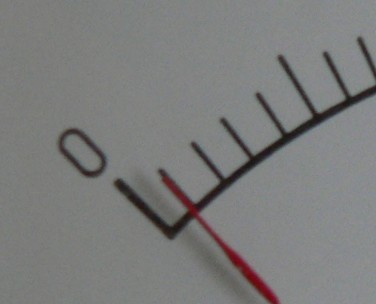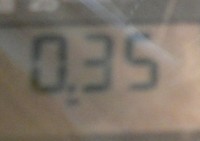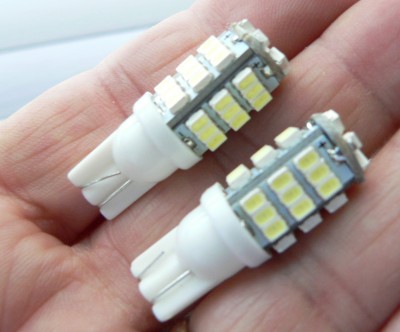index


|
|
RV Maintenance
LED Lighting
|
|
RV Lights
A common bulb in my RV was the Incandescent Wedge-Base 921.
C921: 12V, 1400mA, 18watts, 100 lumens, 5.5 lumens/watt for first 28 hours, decreasing.
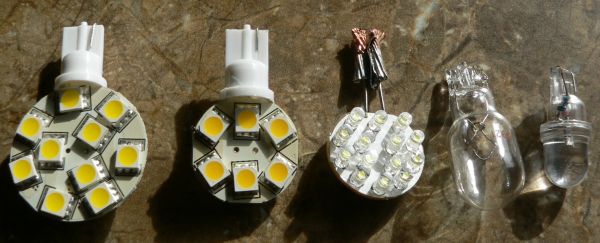
10HiCluster .... 6HiCluster .... 14DescreteCluster .... Incandescent .... Single
|
Five kinds of lights:
Single LED
Incandescent C921 1400mA 260 to 100 Lumens $ 2.00
14-Cluster- Descrete LEDs- 40mA 25 to 35 Lumens SkyBlue $ 8.95
06-Cluster- HyBright LEDs- 145mA- 120 Lumens PureWhite - $11.98
10-Cluster- HyBright LEDs- 230mA- 200 Lumens NaturalWhite- $12.98
These look like two single bulbs, but they actually are two 14-led clusters under the covers.
Almost 100mA for two.
They are simple with no regulation.
Luminosity depends on voltage: 13.99 volts is brighter than 12.60volts.

G-4 Bi-Pin LED Lamp
40mA 10000mCd
|
I replaced almost all my incandescent wedge bulbs (10 Watts and 18 watts) with these LEDs,
(0.5Watts)from Marlin P. Jones.
You will have to place some solder
on the leads for "bulk" so that the thin G-4 wire leads will be thick enough to go securely into a Wedge socket.
These LED clusters work either way (polarity), ac or dc.
I tried the smaller direct wedge replacements common for RVs, but they do not produce much light at all.
The only application for the "direct replacement" lamps is where space is limited, as the lamps are of the same
physical dimensions as the small incandescent. You may have to resolder an LED connection or two on the
back side. Mine had this flaw, but easily fixed. There should be 14 lit LEDs. They work great! The light is noticeably on the "hot-blue" side,
in contrast to an incandescent "warm red glow". And the amount of light is adequate for reading, and only seems a little less than incandescents.
The incandescent is 260 Lumens to 90 lumens, depending on your coach voltage and bulb age.
If you are dead set on 100 lumens you will have to fork
out big bucks: $12.98 from PrudentRVer; but my "adequate" ones are only $8.95.
If you have the space in the fixture, these are easily modified and produce good light:
10,000mCd in its normal 90 degree pattern implies that
the source is about 20 Lumens.
But I know it should be more, because in general good LEDs produce at least 50 Lumens/watt.
So, don't pass up this overlooked bargain.
New Incandescent on the left, 14-cluster on right.
This new incandescent is WAY brighter than the 14-cluster!
But I am not buying any more because
I have an old bulb that is turning black, and I can not tell the difference in Luminosity between it and
the 14-cluster.
And at almost an amp and a half, the lense gets real hot.
6-Cluster on the left, 14-cluster on right.
6-Cluster is slightly brighter.
8-Cluster on the left, 14-cluster on right.
For a dollar more you can go to 200Lumins.
200Lumins is definitely much brighter.
 A failed HiCluster at 2 months.
A failed HiCluster at 2 months.
|
A disadvantage of these Disc clusters is that they use auxiliarly electronics.
They have two electrolytics and a chip or two on the back sides, and thus
have a limited lifetime. Perhaps 5 years. I have had electrolytics fail in as little as
one year! In addition, they are multilayer. They are prone to erratic connections.
The HiCluster in the picture failed in only two months!
In contrast, the discrete LED and discrete LED cluster have no associated electronics and can live to the
full capacity life of the LEDs: decades.
"Simple" clusters with no regulation, may have one disadvantage:
Some unscrupulous manufacturers drive their LEDs
full-out, with no headroom.
If your house voltage goes above 12.60 volts you can burn them out.
Personally, I have had no problem with coach voltages at 13.98 to 14.00 volts.
I have seen manufactures, shove more than 20mA through LEDs, and they have "hung on" for 5
years, all the while, growing dimmer and dimmer.
Current density is the big killer, followed by heat, and in the case of white LEDs, phosphor degredation.
Of course, they can just totally fail. Quit!
Your controller is probably not as good as mine, and with it's temperature control seeing freezing
battery conditions, may send your voltage above 14.00 volts. I forbad mine to do that.
AntiSulfation pulses to the battery can go to 20 volts. But your house voltage better not
be married to it, or your burned out lights will be the least of your worries.
Discretes will dim drastically under low voltage.
And increased voltage, above designed, will give little advantage.
All and all, with tender care, I have seen acceptable performance from discrete LEDs and discrete LED clusters.
...Love um.

Dinette light
HI-08, LED14
|

Hall-AirCon
LED
|

Hall-Woof
HI-06, HI-08
|

BathRoom
LED14, HI-06
|

Bed
LED, LED
|

OutSide
Incandescents
|
 The cheapest way to go. If you can get the small flashlights for about $2 a piece...
The cheapest way to go. If you can get the small flashlights for about $2 a piece...

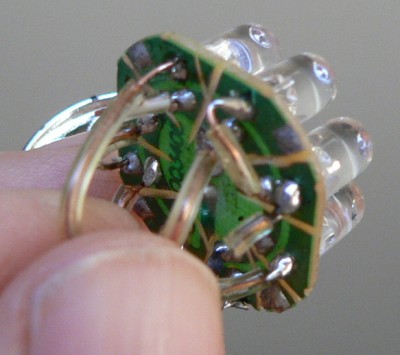
They easily come apart:
Take a nutdriver (recessed socket so as not to damage the LED assembly) and push out LED Assembly out the front.
You will see the LEDs are all wired in parallel.
Each LED operates on the three-battery voltage of 4.5 volts.
The current is excessive at 0.27amps, and the LEDs will quickly and permanetly dim.
I took a dremmel tool and cut the traces, not allowing parallel operation.
To allow 12 volt operation, I wired for two sets of 4 LEDs in series.
I also wired for three sets of 3 LEDs in series, but it was not much brighter.
So, I choose to not use the center LED, and go with two sets of 4 LEDs.
 Here are two flashlight assemblies installed in my 12 volt stove hood.
The two assemblies are brighter than the original incandescent, and now use little current.
The disadvantage is that you have to solder the wires into the light circuit.
But you should use a resister to stay out of overdrive.
But you should never have to return here, and never have to replace any bulbs.
Here are two flashlight assemblies installed in my 12 volt stove hood.
The two assemblies are brighter than the original incandescent, and now use little current.
The disadvantage is that you have to solder the wires into the light circuit.
But you should use a resister to stay out of overdrive.
But you should never have to return here, and never have to replace any bulbs.
If you do not want to cut any traces, you can buy three or four flashlights,
and wire the intire complete LED assemblies in series, obtaining huge brightness levels.
I will do that next time; More is better! ...And easier.
 Continuing on with Flashlights...
Continuing on with Flashlights...
Got these at Harbor Fright for two for $3.00.
Each 9 LED flashlight is about 15 Lumens.
At a current draw of 0.27 amps per 9 LEDs, that is 30mA each.
Meaning you can't leave these flashlights turned on for any length of time: the light will dim.

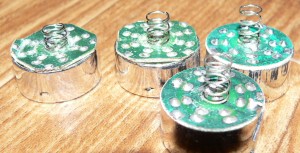
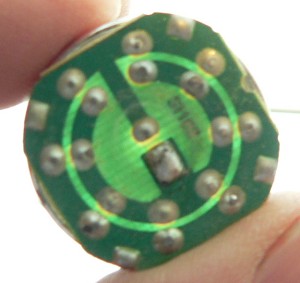 The inside circle is positive, or the LED's anodes. The outside ring is negative, or cathodes.
The inside circle is positive, or the LED's anodes. The outside ring is negative, or cathodes.
The three AAAs measure 4.95 volts. Therefore, four assemblies should be good for about 19 volts.
Four assemblies work at below 10 volts. Therefore the supply range is approximately 10 volts to 19 volts.
A properly designed, off the Grid, RV will supply from 11 volts to 14 volts.
If you look at the assembly design, aprox 2 volts must be used up as internal resistance.
This is a cheap, an inefficient design, producing a lot of heat. And, indeed, after about 30 seconds
I can begin to feel heat at the base of all LEDs. Despite this waist, these discrete LEDs are way better
than incandesants, and are as bright as $8.00 Discretes.
At 15 lumens and 4.6 volts and 0.27 amps that is 12 lumens per watt: twice as good as the incondescents.
The efficiency increases with more LEDs
in series. But the voltage target window narrows. Too much and you burn up the LEDs.
Too little and they will not light at all.
Therefore resistors, and their heat, are necessary, internally or externally, in discrete LEDs for a forgiving supply voltage.
Resistors are mitagators.
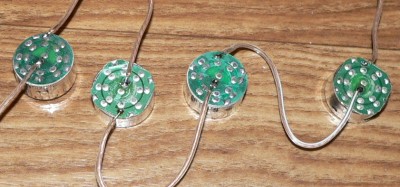 Wire the assemblies Positive supply to the first Assembly's Anodes.
Positive Supply Wire is coming from left at bottom.
Wire the assemblies Positive supply to the first Assembly's Anodes.
Positive Supply Wire is coming from left at bottom.
Wire Cathodes of first Assembly to Anodes of second Assembly. And so on...
Negative Supply is at upper right.
 The current, on a 12 volt RV system,
for all four Discrete LED assemblies in series is aprox 500mA at 13 volts.
That is 4 LEDs in series and 9 in parallel.
That is about 500/9 55mA per LED, which is too much.
Will have to add a resister.
The current, on a 12 volt RV system,
for all four Discrete LED assemblies in series is aprox 500mA at 13 volts.
That is 4 LEDs in series and 9 in parallel.
That is about 500/9 55mA per LED, which is too much.
Will have to add a resister.
 The cost value of $1.50 of each assembly is worth the three AAA batts alone, not to mention the $8.00 value of LEDs.
The cost value of $1.50 of each assembly is worth the three AAA batts alone, not to mention the $8.00 value of LEDs.
Took the incandescent bulb out of the center, as you can see, because it pulled 1.3 Amps.
If I had not done this,
the socket in time would turn brown, then black, and finally start to crumble.
These LEDs are bright. Totally blinded me for about a minute with all four going.
Each assembly is as bright as the one incandescent bulb.
The incandesant bulb produces a warm orange light, and the LEDs produce a sharp
blue light that looks like "daylight".
After all, the source of most white light LEDs is
blue or ultraviolet activating different phosphors.
Used HotGlue to temporarily hold Acrylic Urethane Chalking.
Did not want to use Epoxy nor Silicon as
both are impossible to remove. And both are difficult to apply without a mess.
And cured silicon is a magnet for dirt.
It will shout "patch-job" with an ugly brown dirt coating.
Acrylic Urethane is water soluble, and
can be nicely manicured with your finger.
I can not explain it, but Acrylic Urethane also
both sticks better than silicone and also is easier to remove.
The HotGlue will not work at all as the bases of all LEDs can get too hot.
But it does not matter how many times the HotGlue melts and resolidifies, the Acrylic Urethane is what is holding
the LEDs. Also some cooling will accur as the HotGlue melts.
Gorilla Tape works better than HotGlue, if you remember to remove the tape.
There is the haunting question of distribution of current.
Certain LEDs could permanently grow dim from over current;
and the effect would detrimentally cascade.
Therefore, after installation I will add a resistor.
After installation:
0.15 amps, 0 ohms resistor pluss wiring losses
0.03 amps, 50 ohm resistor
0.07 amps, 10 ohm resistor
7.8mA per LED. A little light but safe. A 5 ohm would be better but I don't have any.
For example, here are flashlight LEDs under the kitchen sink.
This light in the corner is only one of eight scattered elsewhere.
They come on automatically when the door is opened.
You can see something white in the extreme top left corner. That is a contact switch.
I normally use magnetic reed switches but can no longer obtain them from Radio Shack or Home Depot.
But that is OK; I have several vane contact switches in my junk box.
I have not seen automatically-lighted-cubbards anywhere in any RV.
I have not seen them in Trailers, Fifthwheels, or expensive Motorhomes.
It is a shame, because this thing is a real nice feature.
Group2 pulls 0.29A with no resistor.
and 90mA with a 10 Ohm resistor.
That is 10mA per LED. That should be ok, the brightness is reduced by about a 1/4.
I will trade brightness for longivity.
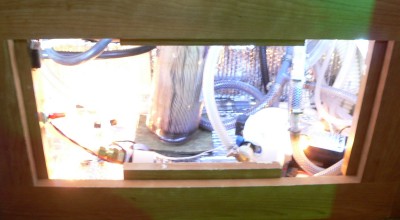 Water Supply Cabinet
Water Supply Cabinet
I like lots of light. Lots of light! Almost as bright as daylight in this cabinet!
And here is another set of quad assemblies made from flashlights. These lights are in the water
supply cabinet. The digital meter says about 350mA.
Added a 10 ohm resistor here too.
And God said, Let there be light: and there was light. ...
Genesis 1
|
LEDs have made this little RV Trailer the brightest thing in the RV park.
And it is not even connected to the Grid!

Update...
Well, not so fast.
After two years, the homemade LED clusters are growing dim. I don't know why.
I think it is overvoltage.
The voltage can go to 14 volts.
In winter, these lights are part of the incadesents used for heating.
The inside of the coach,
especially around all water lines and filters is heated by incadesent light bulbs.
And for no design reason some of these LED lights came along for the ride.
Also, some of these lights come along for the ride on Reject power.
The point is that some of these lights are on many hours a day.
They are on for unknown reasons, but they use little power, and were given little thought.
The problem is that these lights have "wore out" due to too high of voltage.
This year the problem has been fixed. ...Too late for these homemade lights.
Now, no voltage inside the coach is higher than 12.04 volts.
This should extend the life of LEDs.


 A failed HiCluster at 2 months.
A failed HiCluster at 2 months.


 Here are two flashlight assemblies installed in my 12 volt stove hood.
The two assemblies are brighter than the original incandescent, and now use little current.
The disadvantage is that you have to solder the wires into the light circuit.
But you should use a resister to stay out of overdrive.
But you should never have to return here, and never have to replace any bulbs.
Here are two flashlight assemblies installed in my 12 volt stove hood.
The two assemblies are brighter than the original incandescent, and now use little current.
The disadvantage is that you have to solder the wires into the light circuit.
But you should use a resister to stay out of overdrive.
But you should never have to return here, and never have to replace any bulbs.


 The inside circle is positive, or the LED's anodes. The outside ring is negative, or cathodes.
The inside circle is positive, or the LED's anodes. The outside ring is negative, or cathodes.
 Wire the assemblies Positive supply to the first Assembly's Anodes.
Positive Supply Wire is coming from left at bottom.
Wire the assemblies Positive supply to the first Assembly's Anodes.
Positive Supply Wire is coming from left at bottom.
 The current, on a 12 volt RV system,
for all four Discrete LED assemblies in series is aprox 500mA at 13 volts.
That is 4 LEDs in series and 9 in parallel.
That is about 500/9 55mA per LED, which is too much.
Will have to add a resister.
The current, on a 12 volt RV system,
for all four Discrete LED assemblies in series is aprox 500mA at 13 volts.
That is 4 LEDs in series and 9 in parallel.
That is about 500/9 55mA per LED, which is too much.
Will have to add a resister.
 The cost value of $1.50 of each assembly is worth the three AAA batts alone, not to mention the $8.00 value of LEDs.
The cost value of $1.50 of each assembly is worth the three AAA batts alone, not to mention the $8.00 value of LEDs.
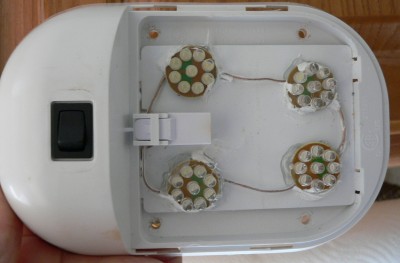
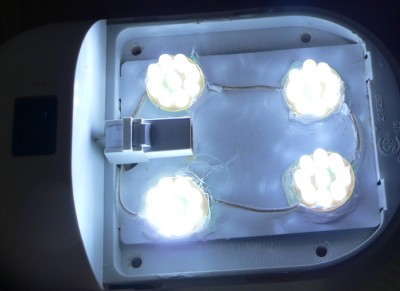
 Water Supply Cabinet
Water Supply Cabinet